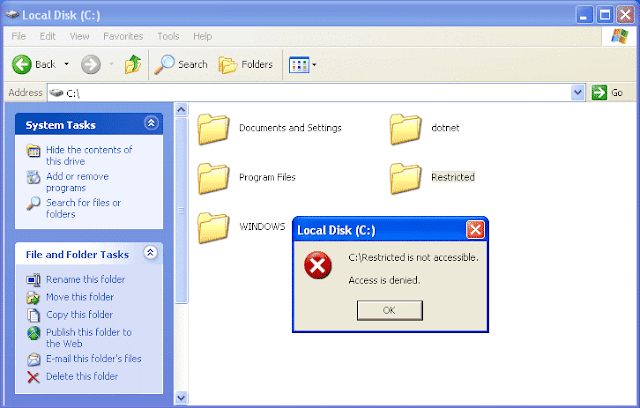
Hard drive failure and recovery
The hard drive is one of the major storage components of a computer system. It stores various kinds of data like text, pictures, audios, videos, etc. Any problem arising in such hard drives could lead to inaccessibility of the data present in it. Such inaccessibility is often supported by various error messages. One of the most common error messages that make the hard drives inaccessible is “Hard Drive is not accessible. Access is denied“.
Consider a scenario, where you are working on the D:\ drive on a computer, which consists of audio and video files. While playing some audio files, you might experience that audio is not playing through completely or instead it is playing some other file from a different location. Such a problem can be easily fixed by restarting the system or re-connecting the device if the file is on an external hard drive.
However, the problem can re-occur after some time. Also, you might experience some issues with the hard drive. A severe issue with your hard disk could deny you any further operations like creating or deleting of any folder on the hard drive. You can make use of the error checking tool to overcome this problem by navigating to Properties->Tools->Check Now. If you are lucky, you will not face the issue again while accessing the HDD and would be able to perform all operations on the hard drive.
Else, you would still be denied the hard drive access. In spite of the presence of drive icon in the Explorer, you might get the following error message.
“D:\ is not accessible. Access is denied.”
What is this error?
The error message indicates that there is some problem with the hard drive, which has made the hard drive inaccessible. In the worst case, it could also lead to data loss.
Why do we face it?
The issues mentioned above can be experienced in many different situations as well as different versions of operating systems. The error message indicates that the hard drive has gone corrupt. To get over from the situation, you can follow any of the two solutions mentioned below Automatic and Manual.
Automatically fix this Error
To solve hard drive inaccessibility issues, formatting will be the sure shot way. However, the stored data may be compromised, and you may permanently lose access to it. To avoid losing data, you can use data recovery programs that can recover data from the inaccessible hard drive without altering the file attributes.Use Stellar Phoenix Windows Data Recovery – Pro to recover files from the inaccessible hard drive or any other storage media with similar issues. You can free download this data recovery software on any latest Windows machine and begin scanning the formatted or erased hard drive for your data.
- You can download and install this program and start it from the desktop.
- In this particular case, you can select specific volume giving you access denied error. Once you select the volume, click on Scan button to initiate scanning process.

- You can see the list of recoverable files and folders once the scanning is finished. Click on the checkbox to select files for recovery.
- You can choose a location to save the recovered data.
Manual Ways
For Windows 10If you are running Windows 10 then follow below steps to access your inaccessible drive:
- Right-click on the inaccessible drive.
- Now go to the ‘Properties’ section.

- Select the ‘Security’ and click on the ‘Edit’ button.

- The “Permissions for New Volume (E:)” dialog box appears, as shown in the figure below. Click the ‘Add’ button to continue.

- Add a new user named ‘Authenticated User’ and Click ‘OK’.
- From the permission section, give ‘full control’ to newly added user and click ‘OK’.
- The dialog box will show two options: ‘Continue’ or ‘Cancel’.
- Press Continue… and Cancel at last.
- Now, you are done.
For Windows 7
In the case of Windows 7, you might
get that error if you are running HomeGroup and have shared a root drive E:\,
and finally, you have left the HomeGroup. This situation would deny you
any access to the drive that was shared and would give you the following error
message.
F:\ is not accessible. Access is
denied.

Resolution
To resolve this issue, go to the
Windows Explorer and follow the below mentioned steps.
- Right-click on the inaccessible hard drive.
- Click Properties.
- Go to the Security tab, and then click Advanced.
- Click ‘Edit’ by going to the Owner tab.
- Modify the ownership of the desired account.
Alternatively, you can also try the
following option if you are not able to access any file or folder on a Windows
7 drive.
- Right-click on the inaccessible file or folder.
- Click Properties.
- Select the Security tab.
- Click your name Under Group or username. This would show you the permissions you have to access the file and folder.
You can also try the following
method
- Change the drive letter for an inaccessible hard drive.
- Run the following command: chkdsk /r I:
- Try to boot into the safe mode and access the HDD.
- Try accessing the HDD in Windows 7 Ultimate and Home Premium.
- You will be able to access the drive, as chkdsk command would have deleted the files that were causing the problem.
Windows XP
In the case of Windows XP, you might
face the “Access is denied” issue if you have used an earlier version of
Windows to create a volume based on NTFS file system and then installed Windows
XP. A change in the version of the operating system changes the security ID of
the user. As the security ID of the person who created the folder was different
on an earlier version of the Windows, in spite of the same username and
password you do not have the permission to open the folder after you perform
the following steps.
- The actual location of the ‘My Documents’ folder has been changed before installing Windows XP professional.
- Install Windows XP Professional, by formatting the primary partition.

Resolution
Turn off the Simple File Sharing
option and take ownership of the folder.
- Open ‘My Computer’.
- Go to Tools->Folder->View.
- Go to Advanced Settings and clear the Use simple file sharing checkbox.
- Click OK.
- Right-click the desired folder for ownership and click Properties.
- Click the Security tab.
- Click OK on the Security message if any.
- Click Advanced->Owner tab.
- Click your username in the Name list.
- Click OK.
- In case you get an error message, click ‘Yes’.
- Click OK.
- Reapply the permissions and security settings.





